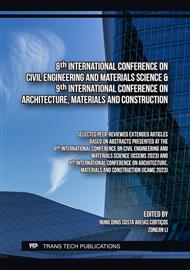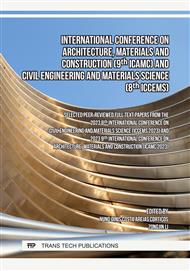p.17
p.27
p.35
p.41
p.47
p.59
p.65
p.79
p.87
The Use of Phase Change Materials for Cooling Applications in the Hot Climate of the UAE
Abstract:
The primary concern of the scientific community nowadays is our reliance on fossil fuels for our energy needs and the resulting greenhouse gas (GHG) emissions. It is now widely accepted that non-renewable energy sources are scarce and that renewable energy sources are now widely facts. The building sector is one of the largest energy consumers, accounting for about 40% of overall energy consumption, being dependent on heating and cooling systems. Thermal energy storage (TES) is a viable solution for meeting the growing energy demand. TES forms, including sensible, latent, and more importantly latent heat thermal energy storage (LHTES) associated with phase change materials (PCMs), are being investigated by researchers for their potential to improve energy performance in buildings, maintain thermal comfort and reduce pollution. In addition, the district cooling system (DCS) is a centralized system for delivering thermal energy in the form of chilled water, which is then used for dehumidification and space cooling. As compared to traditional cooling systems, DCS coupled with renewable energy is economically viable. A preliminary study was conducted by the authors involving paraffin-based PCM with a melting range of 30–33°C in a thermal energy storage unit. This study investigates PCM based air pre-cooling concept by storing night-time ambient cooling and releasing the same to the fresh air supply stream during the daytime which eventually reduced 20% of the peak cooling demand. The pre-cooling unit is placed in a typical AC duct, where the hot air enters the test chamber with a specified velocity while the PCM containers are placed facing the hot air. The study concluded that PCM enhanced the pre-cooling performance and reduced the outlet air temperature. A drop of 5.5°C occurs in case velocity of 1 m/s. The air conditioning system reduced capacity reached by 28%. In the present study, the optimum use of PCM by incorporating chilled water cooling (instead of night-time air-cooling) is under investigation as the district cooling system delivers chilled water to buildings during the day and night. However, most of the night times, buildings are not in use thus storing night-time chilled water cooling through the PCM and releasing the same during the daytime is expected to substantially drop the cooling load and accordingly the energy bills significantly. In this study, the literature on thermal energy storage systems that incorporate PCMs for cooling applications has been reviewed. Understanding the potential of employing a PCM-based system in a severe, hot climate, evaluating the impact on the thermal load of buildings using a PCM-based air-pre-cooling system, and providing recommendations for the design and implementation of PCM in buildings are the key objectives of the study. PCM-based air-pre-cooling system's experimental and computational analysis has been presented. The study also provides a review of district cooling systems (DCS) to improve efficiency, sustainability, performance, and cost savings.
Info:
Periodical:
Pages:
65-76
Citation:
Online since:
January 2024
Authors:
Price:
Сopyright:
© 2024 Trans Tech Publications Ltd. All Rights Reserved
Share:
Citation:



